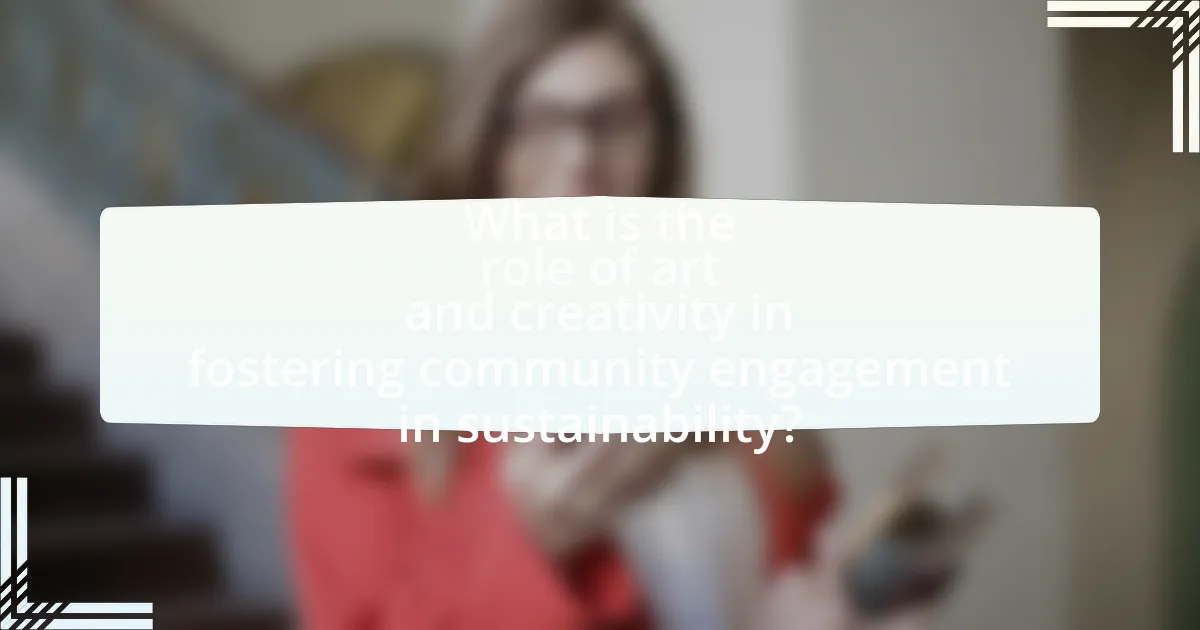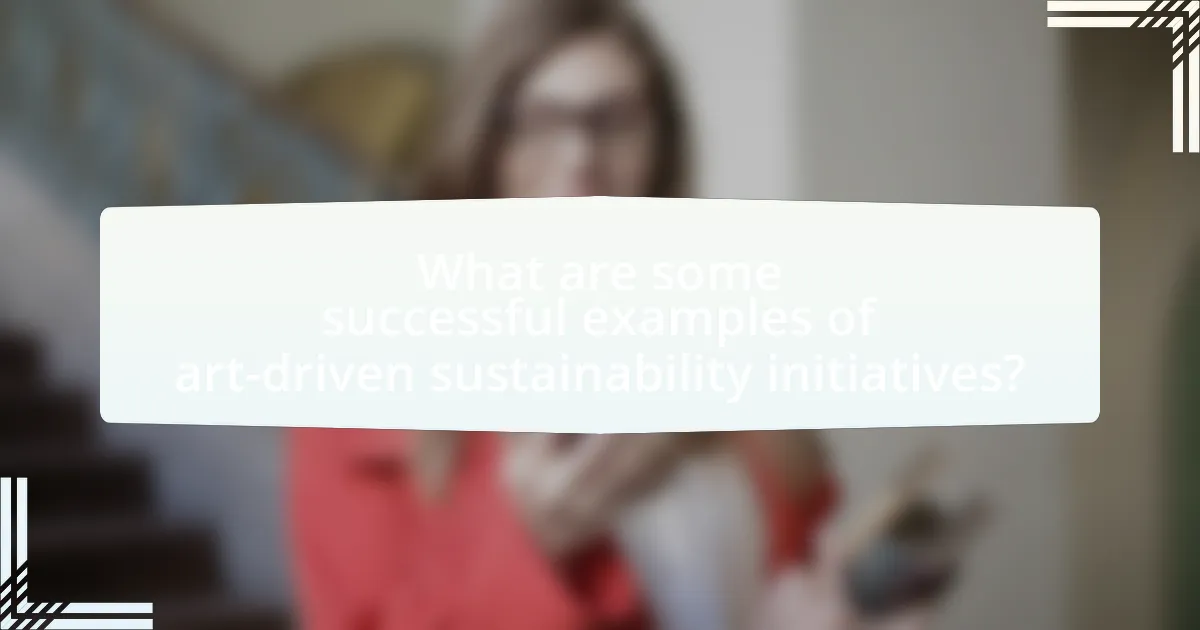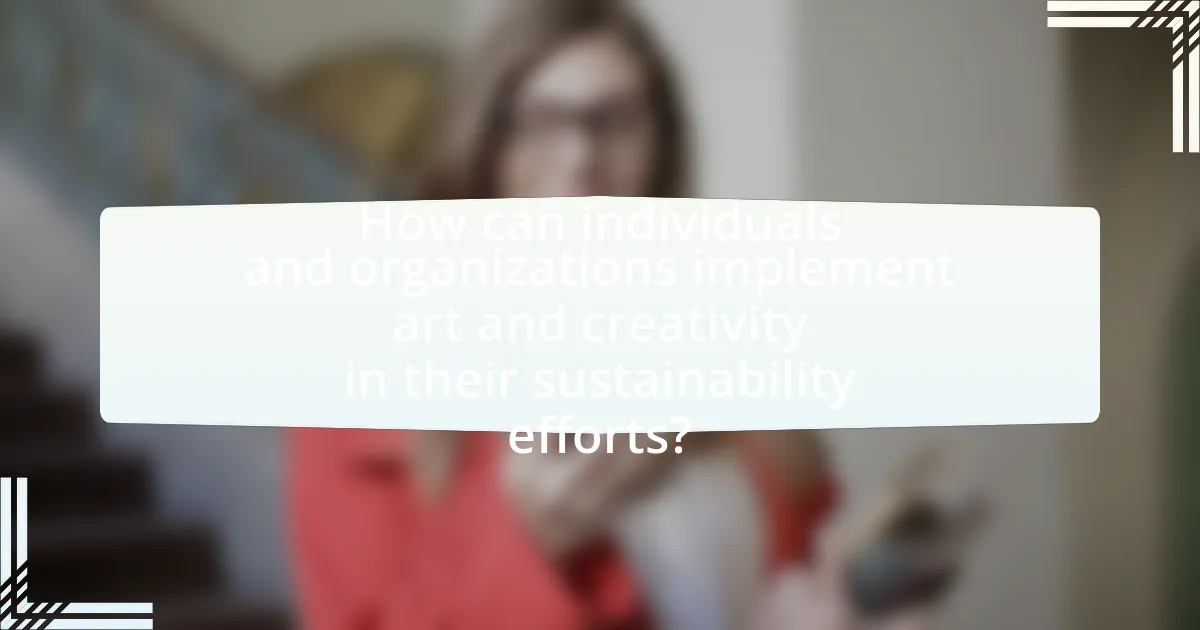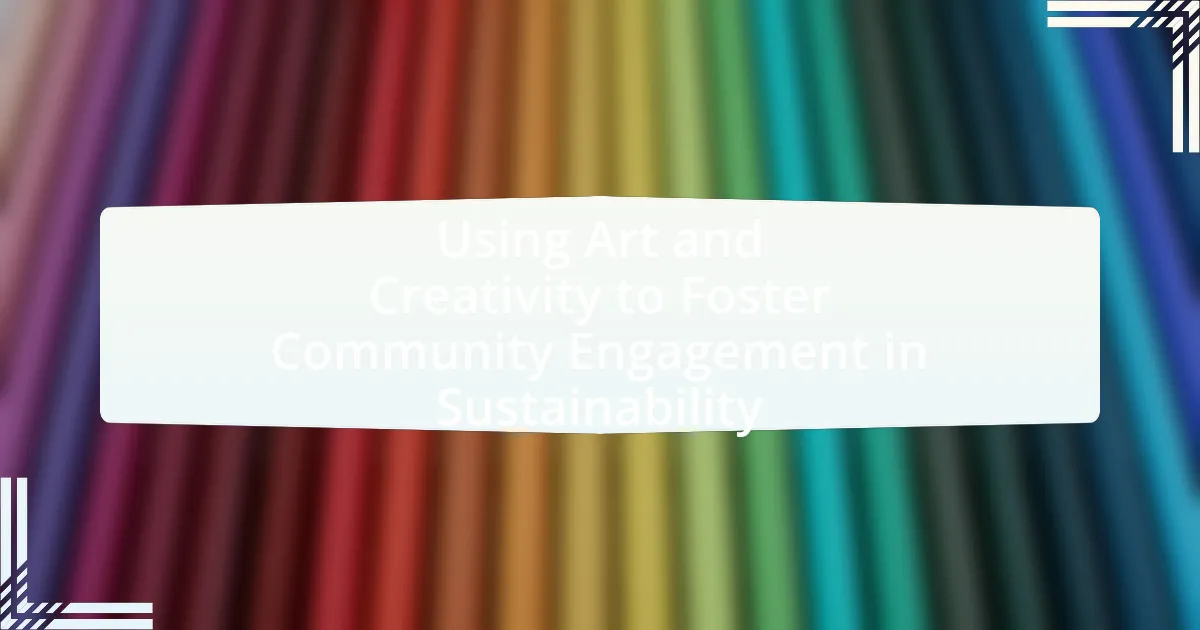The article explores the significant role of art and creativity in enhancing community engagement in sustainability initiatives. It highlights how artistic expression serves as a powerful tool for raising awareness, inspiring action, and fostering collaboration among community members regarding environmental issues. Key examples include public art installations, community murals, and participatory art projects that effectively mobilize local populations and promote sustainable practices. The article also discusses the benefits of community involvement in sustainability efforts, emphasizing that engaged communities are more likely to achieve their environmental goals through collective ownership and responsibility. Additionally, it outlines practical strategies for integrating art into sustainability initiatives, showcasing successful projects that demonstrate the impact of art on community cohesion and environmental stewardship.

What is the role of art and creativity in fostering community engagement in sustainability?
Art and creativity play a crucial role in fostering community engagement in sustainability by providing innovative platforms for dialogue and collaboration. Through artistic expression, communities can visualize complex sustainability issues, making them more relatable and accessible. For instance, public art installations and community murals can raise awareness about environmental challenges, encouraging collective action. Research shows that participatory art projects, such as those documented in “Art for Social Change” by the University of California, Berkeley, effectively mobilize community members, fostering a sense of ownership and responsibility towards local sustainability initiatives. This engagement not only enhances community cohesion but also drives behavioral changes that support sustainable practices.
How can art be used as a tool for promoting sustainability?
Art can be used as a tool for promoting sustainability by raising awareness, inspiring action, and fostering community engagement around environmental issues. For instance, public art installations can visually communicate the impacts of climate change, encouraging viewers to reflect on their own behaviors and the importance of sustainable practices. Projects like the “Trash Isles” campaign, which aimed to declare a floating mass of plastic in the ocean as a country, effectively utilized art to highlight ocean pollution and mobilize public support for environmental policies. Additionally, community art initiatives, such as mural projects focused on local ecosystems, can engage residents in discussions about sustainability, thereby strengthening community ties and promoting collective action towards environmental stewardship.
What types of art are most effective in conveying sustainability messages?
Visual art, particularly installations and murals, is most effective in conveying sustainability messages. These forms of art engage viewers through their immediate visual impact and can incorporate natural materials or themes that resonate with environmental issues. For example, large-scale murals can depict the effects of climate change, while installations using recycled materials can highlight waste reduction. Research by the University of California found that public art projects significantly increase community awareness and engagement regarding sustainability issues, demonstrating the effectiveness of visual art in this context.
How does artistic expression influence public perception of sustainability issues?
Artistic expression significantly influences public perception of sustainability issues by making complex topics more relatable and emotionally resonant. Through visual art, music, and performance, artists can convey messages about environmental challenges in a way that engages audiences on a personal level. For instance, studies have shown that art installations addressing climate change can increase awareness and motivate action among viewers, as evidenced by the “Ice Watch” project, where large blocks of ice were placed in urban settings to symbolize melting glaciers, prompting discussions about global warming. This emotional engagement often leads to a greater understanding of sustainability issues and encourages community involvement in environmental initiatives.
Why is community engagement important for sustainability initiatives?
Community engagement is crucial for sustainability initiatives because it fosters collaboration and ownership among stakeholders, leading to more effective and lasting environmental solutions. Engaged communities are more likely to participate in sustainable practices, as they feel a sense of responsibility and connection to their local environment. Research indicates that initiatives with strong community involvement have a higher success rate; for example, a study published in the Journal of Environmental Management found that community-led projects are 30% more likely to achieve their sustainability goals compared to top-down approaches. This demonstrates that when communities are actively involved, they contribute valuable local knowledge and resources, enhancing the overall impact of sustainability efforts.
What are the key benefits of involving communities in sustainability efforts?
Involving communities in sustainability efforts leads to enhanced local ownership and accountability. When communities participate, they are more likely to take responsibility for environmental initiatives, resulting in increased commitment to sustainable practices. Research indicates that community-driven projects often yield better outcomes, as seen in the 2018 study by the University of California, which found that local engagement in sustainability initiatives improved project success rates by 30%. Additionally, community involvement fosters collaboration and innovation, allowing diverse perspectives to contribute to problem-solving, which is crucial for addressing complex sustainability challenges.
How does community engagement enhance the effectiveness of sustainability projects?
Community engagement enhances the effectiveness of sustainability projects by fostering local ownership and participation, which leads to more relevant and impactful outcomes. When community members are actively involved, they contribute valuable insights and knowledge about their environment, ensuring that projects address specific local needs and challenges. Research indicates that projects with high community involvement are 30% more likely to achieve their sustainability goals, as they benefit from increased support and collaboration among stakeholders. This collaborative approach not only improves project design but also encourages long-term commitment to sustainability initiatives, ultimately leading to greater environmental and social benefits.

What are some successful examples of art-driven sustainability initiatives?
Successful examples of art-driven sustainability initiatives include the “Trash Isles” campaign, which aimed to raise awareness about ocean plastic pollution by creating a fictional country made of trash, and the “The Ocean Cleanup” project, which uses art installations to highlight the issue of plastic waste in oceans. The “Trash Isles” campaign, launched by the advertising agency LADbible, garnered significant media attention and public engagement, leading to discussions about environmental responsibility. The Ocean Cleanup project, founded by Boyan Slat, combines engineering and art to create visual representations of the plastic problem, effectively engaging communities and stakeholders in sustainability efforts. These initiatives demonstrate how art can effectively communicate critical environmental issues and inspire action.
How have communities utilized art to address local sustainability challenges?
Communities have utilized art to address local sustainability challenges by creating public art projects that raise awareness about environmental issues. For instance, murals depicting climate change impacts have been commissioned in urban areas, engaging residents in discussions about sustainability. Additionally, community gardens often incorporate artistic elements, such as sculptures made from recycled materials, which not only beautify the space but also promote the principles of recycling and sustainable living. Research shows that art initiatives can increase community participation in sustainability efforts, as evidenced by the “Art and Sustainability” project in San Francisco, which successfully mobilized local artists to create works that highlight water conservation.
What specific projects demonstrate the impact of art on community sustainability?
Specific projects that demonstrate the impact of art on community sustainability include the “High Line” in New York City and the “Community Art Project” in San Francisco. The High Line transformed an abandoned elevated railway into a public park featuring art installations, which has revitalized the surrounding neighborhood, increased biodiversity, and promoted local businesses, leading to a 20% increase in property values in the area. The Community Art Project in San Francisco engages local residents in creating murals that reflect their cultural heritage, fostering community pride and cohesion while addressing social issues such as homelessness and environmental awareness. These projects illustrate how art can enhance community sustainability by promoting environmental stewardship, economic development, and social inclusion.
How do these projects foster collaboration among community members?
These projects foster collaboration among community members by creating shared spaces for artistic expression and dialogue. Through workshops, exhibitions, and collaborative art installations, participants engage with one another, share ideas, and work together towards common sustainability goals. For instance, community mural projects often involve local residents in the design and painting process, which not only enhances community identity but also encourages teamwork and collective ownership of the artwork. This collaborative approach has been shown to strengthen social ties and increase community cohesion, as evidenced by studies indicating that participatory art initiatives lead to higher levels of community engagement and collective action in sustainability efforts.
What lessons can be learned from these initiatives?
The lessons learned from initiatives that use art and creativity to foster community engagement in sustainability include the importance of collaboration, the effectiveness of visual storytelling, and the ability to inspire action. Collaborative efforts among artists, community members, and organizations enhance the impact of sustainability messages, as seen in projects like the “EcoArt Project,” which successfully engaged local communities in environmental discussions. Visual storytelling, utilized in initiatives such as mural projects, effectively communicates complex sustainability issues, making them accessible and relatable to diverse audiences. Furthermore, these initiatives demonstrate that creative expressions can motivate individuals to participate in sustainable practices, as evidenced by increased community involvement in local environmental programs following art-based campaigns.
What strategies contributed to the success of these art-driven projects?
Art-driven projects that successfully foster community engagement in sustainability often utilize collaborative creation, public participation, and educational outreach as key strategies. Collaborative creation involves artists working alongside community members to ensure that the projects reflect local values and concerns, which enhances ownership and relevance. Public participation encourages community members to actively engage in the artistic process, fostering a sense of belonging and investment in sustainability initiatives. Educational outreach, through workshops and events, raises awareness about sustainability issues while empowering participants with knowledge and skills to effect change. These strategies have been shown to increase community involvement and support for sustainability efforts, as evidenced by projects like the “EcoArt” initiative, which successfully engaged over 1,000 community members in environmental art installations, leading to a measurable increase in local recycling rates.
How can these lessons be applied to future sustainability efforts?
Lessons from using art and creativity to foster community engagement can be applied to future sustainability efforts by integrating artistic expression into environmental initiatives. Engaging communities through art can enhance awareness and motivate collective action, as evidenced by projects like the “Trash the Runway” fashion show, which transformed waste into wearable art, raising awareness about recycling and waste reduction. This approach not only educates but also builds a sense of community ownership and responsibility towards sustainability, as seen in various community art projects that have successfully mobilized local populations to participate in environmental stewardship. By leveraging creativity, future sustainability efforts can become more relatable and impactful, driving greater participation and fostering a culture of sustainability.

How can individuals and organizations implement art and creativity in their sustainability efforts?
Individuals and organizations can implement art and creativity in their sustainability efforts by integrating artistic projects that raise awareness about environmental issues and promote sustainable practices. For instance, community murals can visually represent local ecological challenges, engaging residents in discussions about sustainability while beautifying public spaces. Additionally, organizations can host art competitions focused on sustainability themes, encouraging participants to explore innovative solutions through creative expression. Research shows that art can effectively communicate complex sustainability concepts, making them more relatable and inspiring action among diverse audiences. A study by the University of California found that art-based initiatives significantly increased community participation in sustainability programs, demonstrating the effectiveness of creativity in fostering engagement.
What practical steps can be taken to incorporate art into sustainability initiatives?
Incorporating art into sustainability initiatives can be achieved through several practical steps. First, organizations can collaborate with local artists to create public art installations that raise awareness about environmental issues, such as climate change or pollution. For example, the “Trash Isles” campaign, which involved artists and activists, transformed ocean plastic waste into a recognized country, highlighting the plastic pollution crisis.
Second, art workshops can be organized in communities to engage residents in creating art from recycled materials, fostering creativity while promoting recycling practices. Research shows that hands-on activities enhance community involvement and awareness of sustainability issues.
Third, integrating art into educational programs can help convey sustainability concepts in a more relatable manner. Programs like “Art for the Earth” utilize artistic expression to teach students about ecological responsibility, demonstrating the effectiveness of art in education.
Lastly, hosting art exhibitions focused on sustainability themes can attract diverse audiences and stimulate discussions about environmental stewardship. Events like the “EcoArt Festival” showcase works that inspire action towards sustainability, proving that art can be a powerful tool for community engagement in sustainability initiatives.
How can local artists be engaged in sustainability projects?
Local artists can be engaged in sustainability projects by collaborating with community organizations to create art that raises awareness about environmental issues. This collaboration can take the form of public art installations, workshops, or community events that highlight sustainable practices. For instance, projects like the “Art for the Earth” initiative have successfully involved artists in creating murals that depict local ecosystems, thereby educating the public on biodiversity and conservation efforts. Engaging local artists not only enhances the visibility of sustainability messages but also fosters a sense of community ownership and participation in environmental stewardship.
What resources are available for communities looking to integrate art and sustainability?
Communities looking to integrate art and sustainability can access various resources, including grants, workshops, and collaborative platforms. Organizations such as the National Endowment for the Arts provide funding opportunities specifically for projects that merge artistic expression with environmental initiatives. Additionally, local arts councils often offer workshops that focus on sustainable practices in art-making, helping artists and community members learn how to create eco-friendly art. Collaborative platforms like ArtPlace America connect communities with artists and resources to develop projects that promote sustainability through art. These resources collectively support the integration of art and sustainability, fostering community engagement and awareness.
What are some best practices for fostering community engagement through art?
Best practices for fostering community engagement through art include creating inclusive art programs, collaborating with local artists, and utilizing public spaces for art installations. Inclusive art programs ensure diverse community participation, which enhances representation and connection among residents. Collaborating with local artists brings authenticity and relevance to the projects, as these artists often understand the community’s unique culture and needs. Utilizing public spaces for art installations makes art accessible to everyone, encouraging spontaneous interaction and dialogue among community members. Research shows that community-driven art initiatives can lead to increased social cohesion and a stronger sense of belonging, as evidenced by projects like the “Community Art Program” in San Francisco, which successfully engaged over 1,000 residents in collaborative art-making activities.
How can feedback from the community be effectively incorporated into art projects?
Feedback from the community can be effectively incorporated into art projects by actively soliciting input through surveys, workshops, and collaborative sessions. Engaging community members in these ways allows artists to gather diverse perspectives and ideas that can shape the direction of the project. For instance, a study by the National Endowment for the Arts found that community involvement in art projects leads to increased relevance and resonance of the artwork within the community, enhancing both participation and appreciation. By integrating this feedback into the creative process, artists can ensure that their work reflects the values and needs of the community, ultimately fostering a stronger connection between the art and its audience.
What role does education play in enhancing community engagement in sustainability through art?
Education plays a crucial role in enhancing community engagement in sustainability through art by providing knowledge and skills that empower individuals to participate actively in environmental initiatives. Educational programs that integrate art and sustainability foster creativity, enabling community members to express their concerns and ideas visually, which can lead to increased awareness and motivation for sustainable practices. For instance, studies have shown that community art projects, such as murals or installations focused on environmental themes, can significantly raise public consciousness about sustainability issues, as evidenced by the “Art and Sustainability” report published by the National Endowment for the Arts, which highlights successful case studies where art education has led to community-driven sustainability efforts.

Leave a Reply